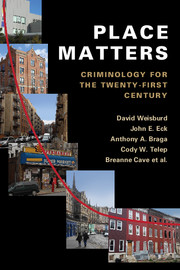Book contents
- Frontmatter
- Contents
- List of figures
- List of tables
- List of contributors
- Preface
- 1 Crime Places within Criminological Thought
- 2 The Concentration of Crime at Place
- 3 Theories of Crime and Place
- 4 The Importance of Place in Mainstream Criminology and Related Fields: Influences and Lessons to be Learned
- 5 Methods of Place-Based Research
- 6 Reducing Crime at High-Crime Places: Practice and Evidence
- 7 Crime Places in the Criminological Imagination
- Notes
- References
- Index
2 - The Concentration of Crime at Place
Published online by Cambridge University Press: 05 April 2016
- Frontmatter
- Contents
- List of figures
- List of tables
- List of contributors
- Preface
- 1 Crime Places within Criminological Thought
- 2 The Concentration of Crime at Place
- 3 Theories of Crime and Place
- 4 The Importance of Place in Mainstream Criminology and Related Fields: Influences and Lessons to be Learned
- 5 Methods of Place-Based Research
- 6 Reducing Crime at High-Crime Places: Practice and Evidence
- 7 Crime Places in the Criminological Imagination
- Notes
- References
- Index
Summary
Take a moment to imagine a crime occurring – perhaps a street robbery or a bag snatch. When you do this, it is difficult not to visualize the crime occurring in a particular setting or place. So, you might imagine a dark street corner with dim street lighting or seating in the outside area of a public bar. It seems intuitively sensible to analyze and understand crime at this unit of analysis – in other words, to investigate how criminals behave and crime concentrates at small microplaces. However, engaging in such microlevel analysis has tended to be a more recent criminological undertaking, and there are still many fruitful avenues to explore in terms of advancing both our knowledge and the sophistication of the methods that we use in this research area.
In this chapter, we raise and endeavor to answer a number of questions concerning the appropriate scale of analysis of criminological enquiry. To do this, we will start by defining what we mean by place and how this differs from other geographic concepts. Next, we highlight what has become the key catalyst for the criminology of place – the tremendous concentration of crime at microgeographic units of analysis. The strong and consistent concentration of crime at addresses, street segments, and other microgeographic units across cities is key to understanding why it is important to study the criminology of place and why it has such strong policy implications. We then turn to some additional statistical benefits of studying crime at microgeographic units that have to do with what is often termed “spatial interaction effects.” Finally, we examine problems that crime and place researchers will need to consider, and recommend some future directions for research exploring crime concentration at places.
PLACE AND SPACE
Geographic concepts are sometimes used in criminological research without a clear understanding of their meaning. Place and space are two such concepts. The subtle difference between them is important to keep in mind, as they can be a guide to establishing a carefully constructed study and influence the interpretation of findings. Furthermore, as will become apparent later in this chapter, a confusion of these concepts can mislead the reader in the interpretation of an argument. For example, it is important to keep in mind that place does not necessarily mean small units of analysis, nor does space necessarily refer to large areas.
- Type
- Chapter
- Information
- Place MattersCriminology for the Twenty-First Century, pp. 16 - 41Publisher: Cambridge University PressPrint publication year: 2016



